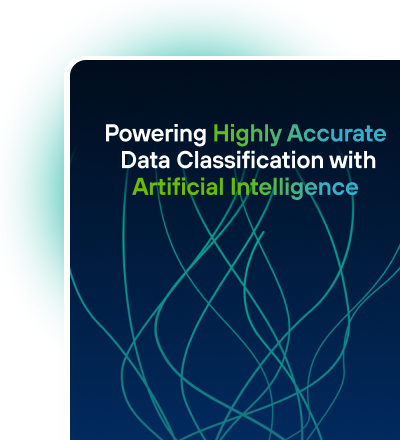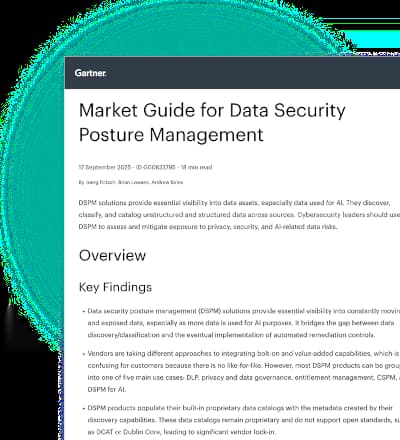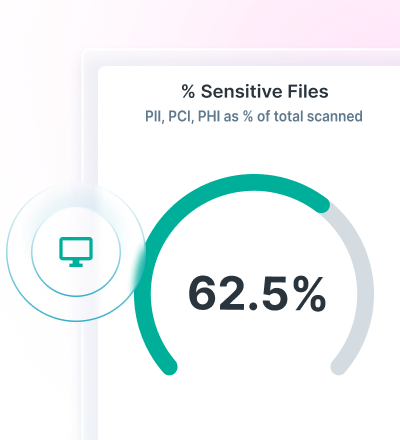أكثر من 12 آلاف عميل يثبتون صحة اختيارنا










































ابحث عن البيانات وقم بفهرستها عبر المؤسسة بسرعة فائقة.


Gartner®: Market Guide for Data Security Posture Management
In their first analysis of the new DSPM security category, Gartner® identifies the five main use cases, breaks down DSPM features and explores the requirements for securing GenAI.
لماذا تختار Forcepoint Data Classification؟
صنّف البيانات عبر مصادر متعددة، واستخدم AI Mesh لتحسين دقتها وكفاءتها باستمرار، ما يوفر للمؤسسات الوقت والموارد الثمينة.
تساعد التغطية على أوسع مجموعة من أنواع البيانات في الصناعة على تبسيط الامتثال، مع توفير حماية أفضل لبيانات المؤسسات.
تجنب الغرامات الباهظة التكلفة لعدم الامتثال من خلال اللوائح الرئيسية المعمول بها وأوسع تغطية لأنواع البيانات في الصناعة.

أمن البيانات في كل مكان تحتاجه. تأمين البيانات في كل مكان مع Forcepoint.
منع الاختراقات، وتبسيط الامتثال، وتوحيد إدارة السياسات، والتكيف مع المخاطر في الوقت الفعلي من خلال حلول أمان البيانات الخاصة بنا.
Forcepoint DLP: حماية المعلومات الحساسة وفرض الامتثال لـ DLP كخدمة (SaaS).
DSPM (Data Security Posture Management): أتمتة اكتشاف البيانات وتصنيفها وتنسيقها للحصول على تحكم كامل ورؤية كاملة لبياناتك عبر المؤسسة.
Risk-Adaptive Protection: ضبط السياسات تلقائيًا بناءً على سلوك المستخدم للتكيف في الوقت الفعلي مع المخاطر الناشئة.
الأسئلة الشائعة
ما المقصود بـ Data Classification؟
Data Classification هو ممارسة وضع علامات على البيانات وتنظيمها في فئات محددة مسبقًا، ما يسهل تحديد موقعها واسترجاعها مع ضمان الوصول الآمن للمستخدمين المعتمدين.
لماذا يعد Data Classification مهمًا للمؤسسات؟
تُعد ممارسات Data Classification ضرورية للحفاظ على وضع أمني قوي. من خلال ضمان معرفة فرق الأمان بمكان العثور على المعلومات الحساسة ووضع قواعد حول من يسمح له بالوصول إليها، يمكنك منع اختراقات البيانات أو احتوائها وإبعاد المستخدمين غير المصرح لهم عن الموارد التي لم يكن ينبغي أن تكون لديهم
ما أنواع Data Classification؟
التصنيف بناءً على المحتوى: هذه ممارسة فحص الملفات والبحث عن معلومات حساسة داخلها. يمكن أن يكون هذا مفيدًا إذا كان لديك مشكلة في المعلومات غير المخصصة للاستهلاك العام مخبأة في أنواع الملفات التي تبدو غير ضارة. التصنيف استنادًا إلى السياق:
بدلاً من فحص محتويات الملفات مباشرة، ينظر هذا النهج في المقام الأول إلى البيانات الوصفية المقترنة بالملفات للعثور على أدلة تشير إلى أن البيانات بداخلها حساسة. قد يشمل ذلك تحديد الموقع الذي تم فيه حفظ الملف أو المستخدم الذي أنشأه أو التطبيق الذي تم إنشاء الملف من أجله. يعمل هذا النهج بشكل جيد عندما تكون قاعدة المستخدمين لديك مدربة تدريبًا جيدًا وعندما يكون لديك بالفعل درجة من التحكم في بياناتك الحساسة.
التصنيف بناءً على المستخدمين: ما يضع العبء على كاهل المستخدمين لفحص الملفات وتصنيفها. على الرغم من أن هذا النهج يمكن أن يقلل بشكل كبير من النتائج الإيجابية الزائفة، إلا أنه لا يعتمد على قاعدة مستخدمين مدربين تدريبًا عاليًا فحسب، بل يعتمد أيضًا على الوقت المتاح لتصنيف البيانات يدويًا. وهذا يعني أنه عادةً ما يكون مناسبًا فقط للمؤسسة الأقل حجمًا أو لمجموعة بيانات أصغر.
ما أفضل الممارسات لتطبيق Data Classification؟
التعريف: ابحث عن مكان تواجد بياناتك الحساسة، بما في ذلك المستودعات السحابية وأقراص الأقراص الثابتة الفعلية، واتخذ أي خطوات فورية ضرورية لتأمينها من خلال التشفير وقواعد الوصول المادي، وغير ذلك.
التنظيم: ابتكر العملية التي ستستخدمها لتنظيم البيانات إلى فئات.
التدريب: تمكين الموظفين من القيام بدور في وضع العلامات على البيانات ووضعها في المكان المناسب بناءً على فئتها. كلما زاد عدد الأشخاص الذين يلعبون دورًا في العملية، كلما كان تدريبك أكثر صرامة للتأكد من أن الأخطاء البشرية لا تؤثر على جهودك.
الامتثال: فهم لوائح أمان البيانات وخصوصية البيانات المعمول بها على عملياتك، بالإضافة إلى العقوبات المفروضة على عدم الامتثال.
الحلول: حدد حل تصنيف البيانات الذي يناسب مؤسستك على أفضل وجه. في كثير من الحالات، قد يكون من الأفضل استخدام منصة شاملة لأمن البيانات يمكن أن تساعد في اكتشاف البيانات وتصنيفها وتحديد الأولويات، بدلاً من معالجة حلول مختلفة معًا من موردين مختلفين.
هل يمكن أن يساعد Data Classification في الامتثال للوائح؟
نعم، يمكن أن يساعد Forcepoint Data Classification على تبسيط الامتثال في أكثر من 80 منطقة. يساعدك على تجنب الغرامات الباهظة التكلفة لعدم الامتثال من خلال اللوائح الرئيسية المعمول بها وأوسع تغطية لأنواع البيانات في الصناعة.
ما مدى دقة Forcepoint Data Classification؟
يستخدم Forcepoint Data Classification الدقة والكفاءة المدعومين من الذكاء الاصطناعي. ويساعد البرنامج على تصنيف البيانات عبر مصادر متعددة، باستخدام تقنية AI Mesh، لتحسين دقتها وكفاءتها باستمرار، ما يوفر للمؤسسات الوقت والموارد الثمينة.
ما المقصود بـ AI Mesh وكيف يتم استخدامه؟
يستخدم Forcepoint Data Classification AI Mesh لتقديم تصنيف البيانات بدقة عالية. تعتمد البنية الشبكية للذكاء الاصطناعي على نموذج لغوي صغير ومكونات ذكاء اصطناعي متقدمة لتحسين الكفاءة وتقليل النتائج الإيجابية الزائفة.











